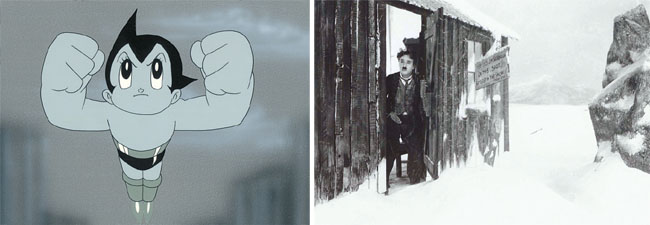Festivals lure audiences out of the multiplex and into the arthouse

There are two film festivals in town: The Tezuka Osamu Film Festival is a collection of early and experimental films by the famed Japanese animator, who is widely known as the father of “Astro Boy,” pictured at left. The Cinematheque Friends Film Festival features films chosen by filmmakers and actors, including the opening film, the 1942 re-release of “The Gold Rush.” Provided by the organizers
There are two film festivals in town: One is the Cinematheque Friends Film Festival where cineastes choose their favorite films each year and share them with movie aficionados. The other is dedicated to famed Japanese animator Tezuka Osamu. Though they differ in purpose, both festivals are geared toward people looking for an alternative to what’s offered by the nation’s three major multiplex chains.
The Cinematheque Friends Film Festival opened yesterday and continues through Feb. 26.
“I feel like movie audiences are less energetic these days when choosing which films to watch,” director Lee Hae-young told reporters at a recent press conference. Lee, known for “Like a Virgin” (2006), is one of 13 directors who helped curate the festival.
The Cinematheque Friends Film Festival was launched back in 2006 to fund Seoul Art Cinema, the only privately run, non-profit theater in Seoul screening art-house films.
Lee said the festival tries to provide viewers with more cinematic options while also exposing them to great films that may not be screened elsewhere. He commented on how broad access to information about the latest big-budget releases has in some ways made people lazy and less adventurous about what they see when they go to the theater.
“These days you can download a trailer onto your smartphone in a few seconds and watch it on the go, but it wasn’t that easy a decade ago, when you had to look at a newspaper to see which movies were playing,” Lee said. “These days, people are more passive. They just go to multiplex chains, where they often have membership cards, and pick the movie that is the most popular. It’s not about watching a film but consuming images.”
The festival aims to get people more involved with the experience of choosing and watching a film.
The festival is curated by a group of 13 filmmakers and seven actors, who choose films under a particular theme. This year, the group was asked to choose films that define the cinema.
Among the filmmakers who helped curate the festival are Lee Chang-dong (“Poetry,” 2010), Lee Myung-se (“The Duelist,” 2005) Ryu Seung-wan (“The Unjust,” 2010), Kim Tae-yong (“Late Autumn,” 2010) and Jeon Gye-su (“Love Fiction,” 2012). They are joined by actors Ahn Sung-ki, Park Jung-hun and Kong Hyo-jin.
Lee Chang-dong’s selection is the film “Scarecrow” (1973) starring Gene Hackman and Al Pacino.
“This a road movie in which two lost young men hit the road in hopes of finding a better future,” Lee said in a press release. “I think the sentiment of the film mirrors the experiences of young Koreans these days.”
This year’s opening film is “The Gold Rush” by Charlie Chaplin.
“It was first produced in 1925 as a silent film, but Chaplin later added narration and music and the new version was re-released in 1942,” said Kim Sung-wook, the festival programmer. “This is the first time the re-release will be screened in Korea.”
The Cinematheque Friends Film Festival runs through Feb. 26 at Seoul Art Cinema in Nakwon-dong, Jongno, central Seoul. Tickets are 6,000 won ($5.20). For more, visit www.cinematheque.seoul.kr or call (02) 741-9782.
The Tezuka Osamu Film Festival is a collection of early and experimental films by the famed Japanese animator. The festival opens today and runs through Jan. 22 at Cine Code Sonje in Sogyeok-dong, Jongno, central Seoul.
The festival screens 11 shorts and seven feature films by the director, often dubbed the god of Japanese manga, including “Astro Boy” (1964) and “Kimba the White Lion” (1966).
“Tezuka is well-known as a creator of family animation in Korea but he tried his best to widen the scope of his creations by making experimental works,” said Kim Ji-eun, who promotes the festival.
According to Kim, Tezuka was open to diverse mediums. Sometimes he inserted black-and-white footage and hand-drawn paintings into his feature films. She said the festival aims to show more of his artistic side.
“Tezuka made many meaningful works but if I had to choose, I’d recommend ‘Pictures at an Exhibition,’ which was inspired by a piece of the same name by Russian composer Modest Mussorgsky,” Kim said. The film brought Tezuka the Silver Lion Award at the Venice Film Festival in 1967.
“And don’t miss his animated films for adults, including ‘A Thousand and One Nights’ [1969] and ‘Cleopatra’ [1970],” Kim said. “Some of the sex scenes are quite graphic or obscene but Tezuka also added artistic touches.”
Tickets are 7,000 won. For more information, visit www.cinecode.co.kr or call (02) 332-5818.
By Sung So-young [so@joongang.co.kr]










with the Korea JoongAng Daily
To write comments, please log in to one of the accounts.
Standards Board Policy (0/250자)